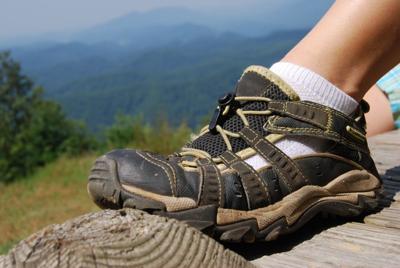You’ll have a better time on your next hike if you’re wearing the right footwear. Follow these tips before hitting the trail.
Your hiking shoe or boot should match the task at hand. If you plan day hikes of no more than 10 miles, you probably don’t need backpacking boots; you’re likely to feel better in hiking shoes or lightweight boots. But don’t let a salesperson talk you out of extra support if you want something sturdier for your ankles or you simply like the protection of a heavier boot.
For hiking, the main choices are trail-running shoes, hiking shoes and hiking boots.
Trail-running shoes are generally beefier than other running shoes and have added protection, support and cushioning. They likely have deeper lugs or tread patterns to help grip the trail, but there is less protection around the toes and more sensitivity under foot than offered by a hiking shoe or boot. In general, they require no break-in period.
Hiking shoes are lighter and more flexible than boots but offer less support. They’re heavier and offer more overall support than trail-running shoes. Some resemble trail-running shoes and other look like low-cut hiking boots. They feature semi-aggressive tread patterns, more durable construction than trail running-shoes and Vibram (or similar) rubber soles. Some models incorporate inner shanks that run the length of the shoe adding support and stability. Rubber toe-caps offer protection when traveling over rocky terrain. Hiking shoes require little or no break-in period.
If most of your miles will be covered in dry, warm weather, a well-ventilated, lightweight shoe is your best bet. Your feet can breathe and you’ll feel better at the end of the day after hiking with the lighter weight. If you anticipate using your shoes in damp or cold weather, look for waterproofing.
Hiking boots are, broadly speaking, more supportive and protective than hiking shoes. They cover the ankles, have harder soles and are made of more durable materials. A beginner or occasional hiker who needs support for less-developed muscles, or who is prone to rolled ankles or tweaked knees, should consider wearing boots.
Materials impact a boot’s weight, breathability, durability and water resistance.
Full-grain leather: Offers durability and good water resistance. Generally used for hiking long distances or over rough terrain. You’ll need to break them in before setting out on a long hike.
Split-grain leather: Usually paired with nylon or nylon mesh to offer lightweight, breathable comfort.
Nubuck leather: A full-grain leather that has been buffed to resemble suede. It is durable and resists water and abrasion. It requires ample time to break in before an extended hike.
Synthetics: Polyester, nylon and synthetic leather are lighter than leather, break in more quickly, dry faster and usually cost less.
Waterproof: Feature uppers constructed with waterproof/breathable membranes (such as Gore-Tex® or eVent®).
Vegan: Made without any animal ingredients or byproducts.
A proper fit is paramount.
Tongue design
The tongue of your shoe or boot might be bellowed or gusseted. A bellowed tongue is designed to keep debris out of the footbed. Fully gusseted tongues are designed to keep water and debris out.
Lacing
Lacing systems – traditional and cord – and eyelet patterns keep shoes on our feet. Traditional laces weave across the top of the foot. Quick lace cord systems also weave across the top of the foot but are secured with a plastic cord lock. (The downside: no easy backcountry repair.) No system is better than another; choose what keeps your feet secure, doesn’t chafe and is comfortable.
————————————— Source: REI.com; Running.com; Backcountry.com







(0) comments
Welcome to the discussion.
Log In
Keep it Clean. Please avoid obscene, vulgar, lewd, racist or sexually-oriented language.
PLEASE TURN OFF YOUR CAPS LOCK.
Don't Threaten. Threats of harming another person will not be tolerated.
Be Truthful. Don't knowingly lie about anyone or anything.
Be Nice. No racism, sexism or any sort of -ism that is degrading to another person.
Be Proactive. Use the 'Report' link on each comment to let us know of abusive posts.
Share with Us. We'd love to hear eyewitness accounts, the history behind an article.